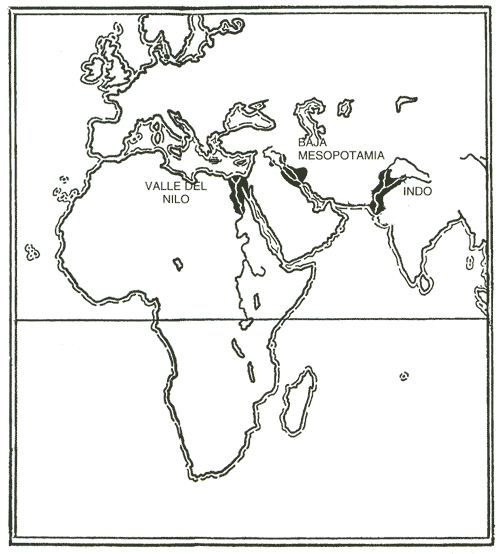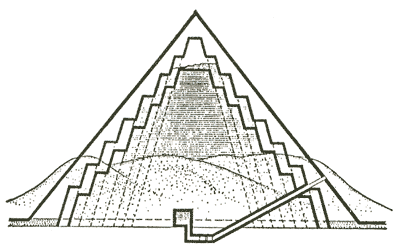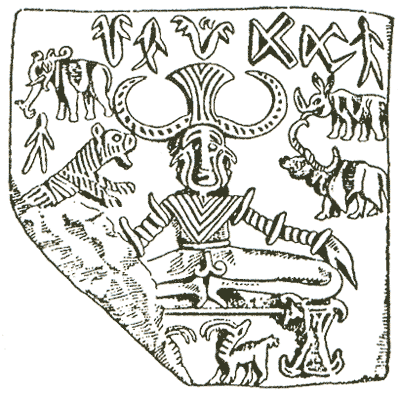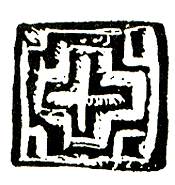|
Kingship on Earth
THE DELUGE, a traumatic experience for Mankind, was no less so for
the "gods" - the Nefilim.
In the words of the Sumerian king lists, "the Deluge had swept
over," and an effort of 120 shar's was wiped away overnight. The
south African mines, the cities in Mesopotamia, the control center
at Nippur, the spaceport at Sippar - all lay buried under water and
mud. Hovering in their shuttlecraft above devastated Earth, the
Nefilim impatiently awaited the abatement of the waters so that they
could set foot again on solid ground.
How were they going to survive henceforth on Earth when their cities
and facilities were gone, and even their manpower - Mankind - was
totally destroyed?
When the frightened, exhausted, and hungry groups of Nefilim finally
landed on the peaks of the "Mount of Salvation," they were clearly
relieved to discover that Man and beast alike had not perished
completely. Even Enlil, at first enraged to discover that his aims
had been partly frustrated, soon changed his mind.
The deity's decision was a practical one. Faced with their own dire
conditions, the Nefilim cast aside their inhibitions about Man,
rolled up their sleeves, and lost no time in imparting to Man the
arts of growing crops and cattle. Since survival, no doubt, depended
on the speed with which agriculture and animal domestication could
be developed to sustain the Nefilim and a rapidly multiplying
Mankind, the Nefilim applied their advanced scientific knowledge to
the task.
Unaware of the information that could be culled from the biblical
and Sumerian texts, many scientists who have studied the origins of
agriculture have arrived at the conclusion that its "discovery" by
Mankind some 13,000 years ago was related to the neothermal ("newly
warm") elimalti that followed the end of the last ice ago. Long
before modern scholars, however, the Bible also related the
beginnings of agriculture to the aftermath of the Deluge.
"Sowing and Harvesting" were described in Genesis us divine gifts
granted to Noah and his offspring as part of the post-Diluvial
covenant between the Deity and Mankind:
For as long as the Earth's days shall be,
There shall not cease
Sowing and Harvesting,
Cold and Warmth,
Summer and Winter,
Day and Night.
Having been granted the knowledge of agriculture, "Noah as a
Husbandman was first, and he planted a vineyard": He became the
first post-Diluvial farmer engaged in the deliberate, complicated
task of planting.
The Sumerian texts, too, ascribed to the gods the granting to
Mankind of both agriculture and the domestication of animals.
Tracing the beginnings of agriculture, modem scholars have found
that it appeared first in the Near East, but not in the fertile and
easily cultivated plains and valleys. Rather, agriculture began in
the mountains skirting the low-lying plains in a semicircle.
Why
would farmers avoid the plains and limit their sowing and reaping to
the more difficult mountainous terrain?
The only plausible answer is that the low-lying lands were, at the
time when agriculture began, uninhabitable; 13,000 years ago the
low-lying areas were not yet dry enough following the Deluge.
Millennia passed before the plains and valleys had dried
sufficiently to permit the people to come down from the mountains
surrounding Mesopotamia and to settle the low-lying plains.
This,
indeed, is what the Book of Genesis tells us: Many generations after
the Deluge, people arriving "from the East" - from the mountainous
areas east of Mesopotamia - "found a plain in the land of Shin'ar
[Sumer], and settled there."
The Sumerian texts state that Enlil first spread cereals "in the
hill country" - in the mountains, not in the plains - and that he
made cultivation possible in the mountains by keeping the
floodwaters away. "He barred the mountains as with a door." The name
of this mountainous land east of Sumer, E.LAM, meant "house where
vegetation germinated."
Later, two of Enlil's helpers, the gods
Ninazu and Ninmada, extended the cultivation of cereals to the
low-lying plains so that, eventually,
"Sumer, the land that knew not
grain, came to know grain."
Scholars, who have now established that agriculture began with the
domestication of wild emmer as a source of wheat and barley, are
unable to explain how the earliest grains (like those found at the Shanidar cave) were already uniform and highly specialized.
Thousands of generations of genetic selection are needed by nature
to acquire even a modest degree of sophistication. Yet the period,
time, or location in which such a gradual and very prolonged process
might have taken place on Earth are nowhere to be found. There is no
explanation for this botanogenetic miracle, unless the process was
not one of natural selection but of artificial manipulation.
Spelt, a hard-grained type of wheat, poses an even greater mystery.
It is the product of "an unusual mixture of botanic genes," neither
a development from one genetic source nor a mutation of one source.
It is definitely the result of mixing the genes of several plants.
The whole notion that Man, in a few thousand years, changed animals
through domestication, is also questionable.
Modem scholars have no answers to these puzzles, nor to the general
question of why the mountainous semicircle in the ancient Near East
became a continuous source of new varieties of cereals, plants,
trees, fruits, vegetables, and domesticated animals.
The Sumerians knew the answer. The seeds, they said, were a gift
sent to Earth by Anu from his Celestial Abode. Wheat, barley, and
hemp were lowered to Earth from the Twelfth Planet. Agriculture and
the domestication of animals were gifts given to Mankind by Enlil
and Enki, respectively.
Not only the presence of the Nefilim but also the periodic arrivals
of the Twelfth Planet in Earth's vicinity seem to lie behind the
three crucial phases of Man's post-Diluvial civilization:
agriculture, circa 11,000 B.C., the Neolithic culture, circa 7500
B.C., and the sudden civilization of 3800 B.C. took place at
intervals of 3,600 years.
It appears that the Nefilim, passing knowledge to Man in measured
doses, did so in intervals matching the periodic returns of the
Twelfth Planet to Earth's vicinity. It was as though some on-site
inspection, some face-to-face consultation possible only during the
"window" period that allowed landings and takeoffs between Earth and
the Twelfth Planet, had to take place among the "gods" before
another "go ahead" could be given.
The "Epic of Etana" provides a glimpse of the deliberations that
took place. In the days that followed the Deluge, it says:
The great Anunnaki who decree the fate
sat exchanging their counsels regarding the land.
They who created the four regions,
who set up the settlements, who oversaw the land,
were too lofty for Mankind.
The Nefilim, we are told, reached the conclusion that they needed an
intermediary between themselves and the masses of humans.
They were,
they decided, to be gods - elu in Akkadian, meaning "lofty ones." As
a bridge between themselves as lords and Mankind, they introduced
"Kingship" on Earth: appointing a human ruler who would assure
Mankind's service to the gods and channel the teachings and laws of
the gods to the people.
A text dealing with the subject describes
the situation ' before either tiara or crown had been placed on a
human head, or scepter handed down; all these symbols of Kingship -
plus the shepherd's crook, the symbol of righteousness and justice -
"lay deposited before Anu in Heaven." After the gods had reached
their decision, however, "Kingship descended from Heaven" to Earth.
Both Sumerian and Akkadian texts state that the Nefilim retained the
"lordship" over the lands, and had Mankind first rebuild the pre-diluvial
cities exactly where they had originally been and as they had been
planned: "Let the bricks of all the cities be laid on the dedicated
places, let all the [bricks] rest on holy places." Eridu, then, was
first to be rebuilt.
The Nefilim then helped the people plan and build the first royal
city, and they blessed it.
"May the city be the nest, the place
where Mankind shall repose. May the King be a Shepherd."
The first royal city of Man, the Sumerian texts tell us, was Kish.
"When Kingship was lowered again from Heaven, the Kingship was in
Kish."
The Sumerian king lists, unfortunately, are mutilated just
where the name of the very first human king was inscribed. We do
know, however, that he started a long line of dynasties whose royal
abode changed from Kish to Uruk, Ur, Awan, Hamazi, Aksak, Akkad, and
then to Ashur and Babylon and more recent capitals.
The biblical "Table of Nations" likewise listed Nimrud - the
patriarch of the kingdoms at Uruk, Akkad, Babylon, and Assyria - as
descended from Kish. It records the spread of Mankind, its lands and
Kingships, as an outgrowth of the division of Mankind into three
branches following the Deluge.
Descended from and named after the
three sons of Noah, these were the peoples and lands of Shem, who
inhabited Mesopotamia and the Near Eastern lands; Ham, who inhabited
Africa and parts of Arabia; and Japheth, the Indo-Europeans in Asia
Minor, Iran, India, and Europe.
These three broad groupings were undoubtedly three of the "regions"
whose settlement was discussed by the great Anunnaki. Each of the
three was assigned to one of the leading deities. One of these was,
of course, Sumer itself, the region of the Semitic peoples, the
place where Man's first great civilization arose.
The other two also became sites of flourishing civilizations.
Circa
3200 B.C. - about half a millennium after the blooming of the
Sumerian civilization - statehood, Kingship, and civilization made
their first appearance in the Nile valley, leading in time to the
great civilization of Egypt.
Nothing was known until some fifty years ago about the first major
Indo-European civilization. But by now it is well established that
an advanced civilization, encompassing large cities, a developed
agriculture, a flourishing trade, existed in the Indus valley in
ancient times.
It came into being, scholars believe, some 1,000
years after the Sumerian civilization began.

Ancient texts as well as archaeological evidence attest to the close
cultural and economic links between these two river-valley
civilizations and the older Sumerian one.
Moreover, both direct and
circumstantial evidence has convinced most scholars that the
civilizations of the Nile and Indus not only were linked to, but
were actually offspring of, the earlier civilization of Mesopotamia.
The most imposing monuments of Egypt, the pyramids, have been found
to be, under a stone "skin," simulations of the Mesopotamian
ziggurats; and there is reason to believe that the ingenious
architect who designed the plans for the great pyramids and
supervised their construction was a Sumerian venerated as a god.

The ancient Egyptian name for their land was the "Raised Land," and
their prehistoric memory was that "a very great god who came forth
in the earliest times" found their land lying under water and mud.
He undertook great works of reclamation, literally raising Egypt
from under the waters.
The 'legend" neatly describes the low-lying
valley of the Nile River in the aftermath of the Deluge; this olden
god, it can be shown, was none other than Enki, the chief engineer
of the Nefilim.
Though relatively little is known as yet regarding the Indus valley
civilization, we do know that they, too, venerated the number twelve
as the supreme divine number; that they depicted their gods as
human-looking beings wearing horned headdresses; and that they
revered the symbol of the cross - the sign of the Twelfth Planet.


If these two civilizations were of Sumerian origin, why are their
written languages different?
The scientific answer is that the
languages are not different. This was recognized as early as 1852,
when the Reverend Charles Foster (The One Primeval Language) ably
demonstrated that all the ancient languages then deciphered,
including early Chinese and other Far Eastern languages, stemmed
from one primeval source - thereafter shown to be Sumerian.
Similar pictographs had not only similar meanings, which could be a
logical coincidence, but also the same multiple meanings and even
the same phonetic sounds - which suggests a common origin. More
recently, scholars have shown that the very first Egyptian
inscriptions employed a language that was indicative of a prior
written development; the only place where a written language had a
prior development was Sumer.
So we have a single written language that for some reason was
differentiated into three tongues: Mesopotamian, Egyptian/Hamitic,
and Indo-European. Such a differentiation could have occurred by
itself over time, distance, and geographical separation. Yet the
Sumerian texts claim that it occurred as the result of a deliberate
decision of the gods, once again initiated by Enlil.
Sumerian
stories on the subject are paralleled by the well-known biblical
story of the Tower of Babel, in which we are told "that the whole
Earth was of one language and of the same words."
But after the
people settled in Sumer, learned the art of brickmaking, built
cities, and raised high towers (ziggurats), they planned to make for
themselves a shem and a tower to launch it. Therefore "did the Lord
mingle the Earth's tongue."
The deliberate raising of Egypt from under the muddy waters, the
linguistic evidence, and the Sumerian and biblical texts support our
conclusion that the two satellite civilizations did not develop by
chance. On the contrary, they were planned and brought about by the
deliberate decision of the Nefilim.
Fearing, evidently, a human race unified in culture and purpose, the
Nefilim adopted the imperial policy: "Divide and rule."
For while
Mankind reached cultural levels that included even airborne efforts
- after which "anything they shall scheme to do shall no longer be
impossible for them" - the Nefilim themselves were a declining lot.
By the third millennium B.C., children and grandchildren, to say
nothing of humans of divine parentage, were crowding the great olden
gods.
The bitter rivalry between Enlil and Enki was inherited by their
principal sons, and fierce struggles for supremacy ensued.
Even the
sons of Enlil - as we have seen in earlier chapters - fought among
themselves, as did the sons of Enki. As has happened in recorded
human history, overlords tried to keep the peace among their
children by dividing the land among the heirs. In at least one known
instance, one son (Ishkur/Adad) was deliberately sent away by Enlil
to be the leading local deity in the Mountain Land.
As time went on, the gods became overlords, each jealously guarding
the territory, industry, or profession over
which he had been given dominion. Human kings were the
intermediaries between the gods and the: growing and spreading
humanity. The claims of ancient kings that they went to war,
conquered new lands, or subjugated distant peoples "on the command
of my god" should not be taken lightly.
Text after text makes it
clear that this was literally so. The gods retained the powers of
conducting foreign affairs, for these affairs involved other gods in
other territories. Accordingly, they had the final say in matters of
war or peace.
With the proliferation of people, states, cities, and villages, it
became necessary to find ways to remind the people who their
particular overlord, or "lofty one," was. The Old Testament echoes
the problem of having people adhere to their god and not "prostitute
after other gods." The solution was to establish many places of
worship, and to put up in each of them the symbols and likenesses of
the "correct" gods.
The age of paganism began.
Following the Deluge, the Sumerian texts inform us, the Nefilim held
lengthy counsels regarding the future of gods and Man on Earth. As a
result of these deliberations, they "created the four regions."
Three of them - Mesopotamia, the Nile valley, and the Indus valley -
were settled by Man.
The fourth region was "holy" - a term whose original literal meaning
was "dedicated, restricted." Dedicated to the gods alone, it was a
"pure land," an area that could be approached only with
authorization; trespassing could lead to quick death by "awesome
weapons" wielded by fierce guards. This land or region was named
TIL.MUN (literally, "the place of the missiles").
It was the
restricted area where the Nefilim had reestablished their space base
after the one at Sippar had been wiped out by the Deluge.
Once again the area was put under the command of Utu/Shamash, the
god in charge of the fiery rockets. Ancient heroes like Gilgamesh
strove to reach this Land of Living, to be carried by a shem or an
Eagle to the Heavenly Abode of the Gods.
We recall the plea of
Gilgamesh to Shamash:
Let me enter the Land, let me raise my Shem... By the life of my
goddess mother who bore me, of the pure faithful king, my father -
my step direct to the Land!
Ancient tales - even recorded history - recall the cease - less
efforts of men to "reach the land," find the "Plant of Life," gain
eternal bliss among the Gods of Heaven and Earth.
This yearning is
central to all the religions whose roots lie deep in Sumer: the hope
that justice and righteousness pursued on Earth will be followed by
an "afterlife" in some Heavenly Divine Abode.
But where was this elusive land of the divine connection?
The question can be answered. The clues are there. But beyond it
loom other questions. Have the Nefilim been encountered since? What
will happen when they are encountered again?
And if the Nefilim were the "gods" who "created" Man on Earth, did
evolution alone, on the Twelfth Planet, create ,
the Nefilim?
Return to Contents
|



